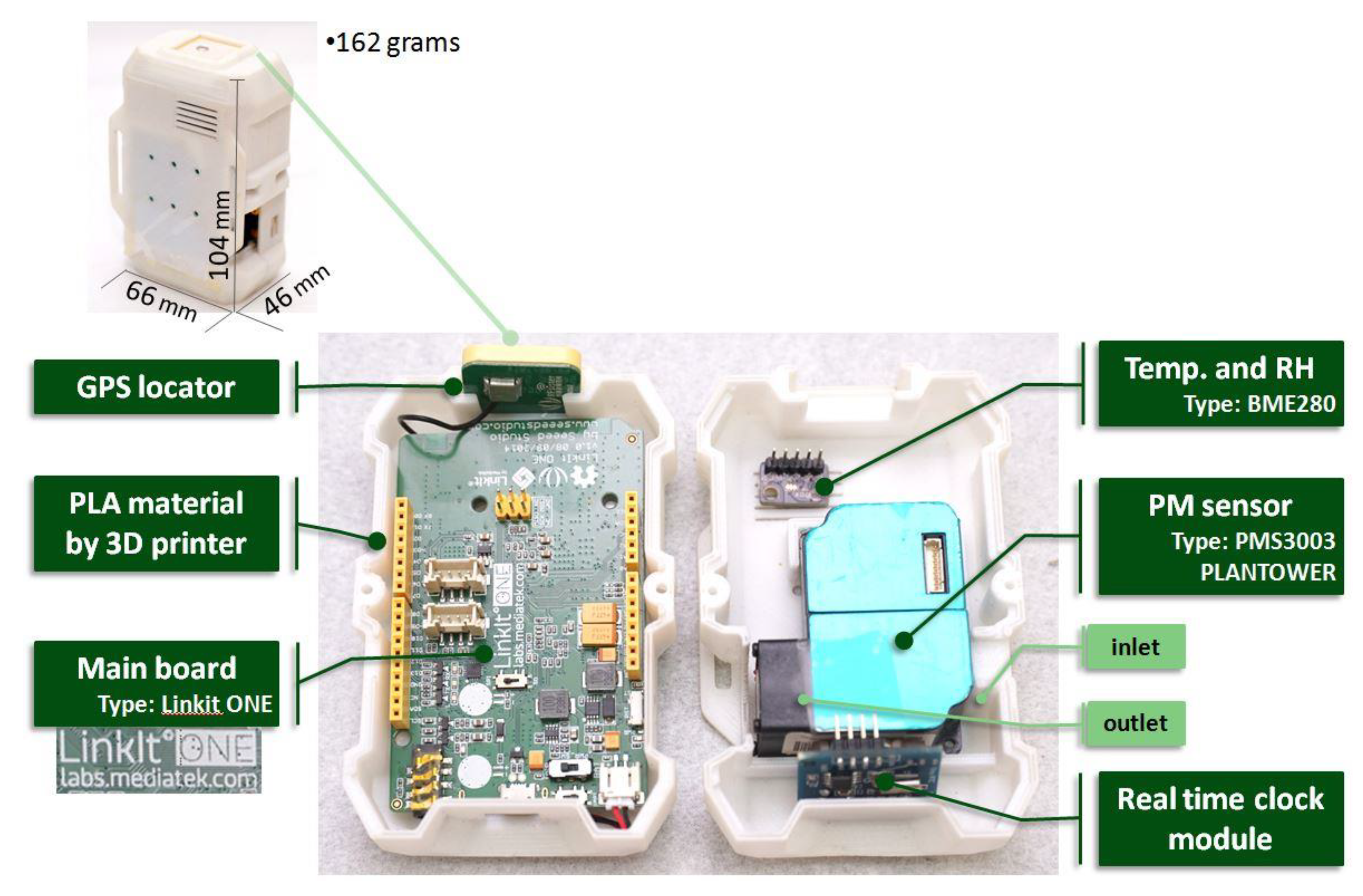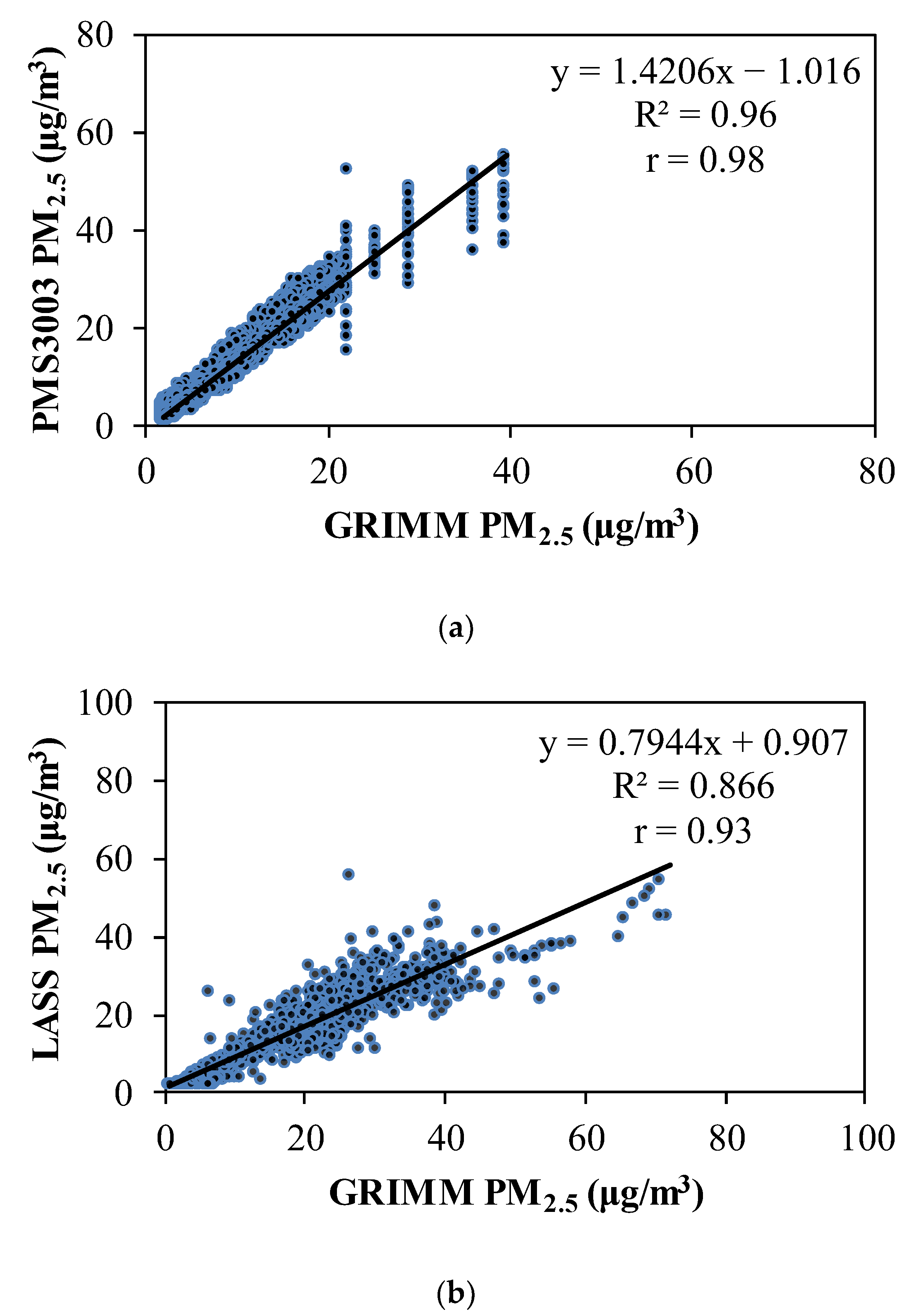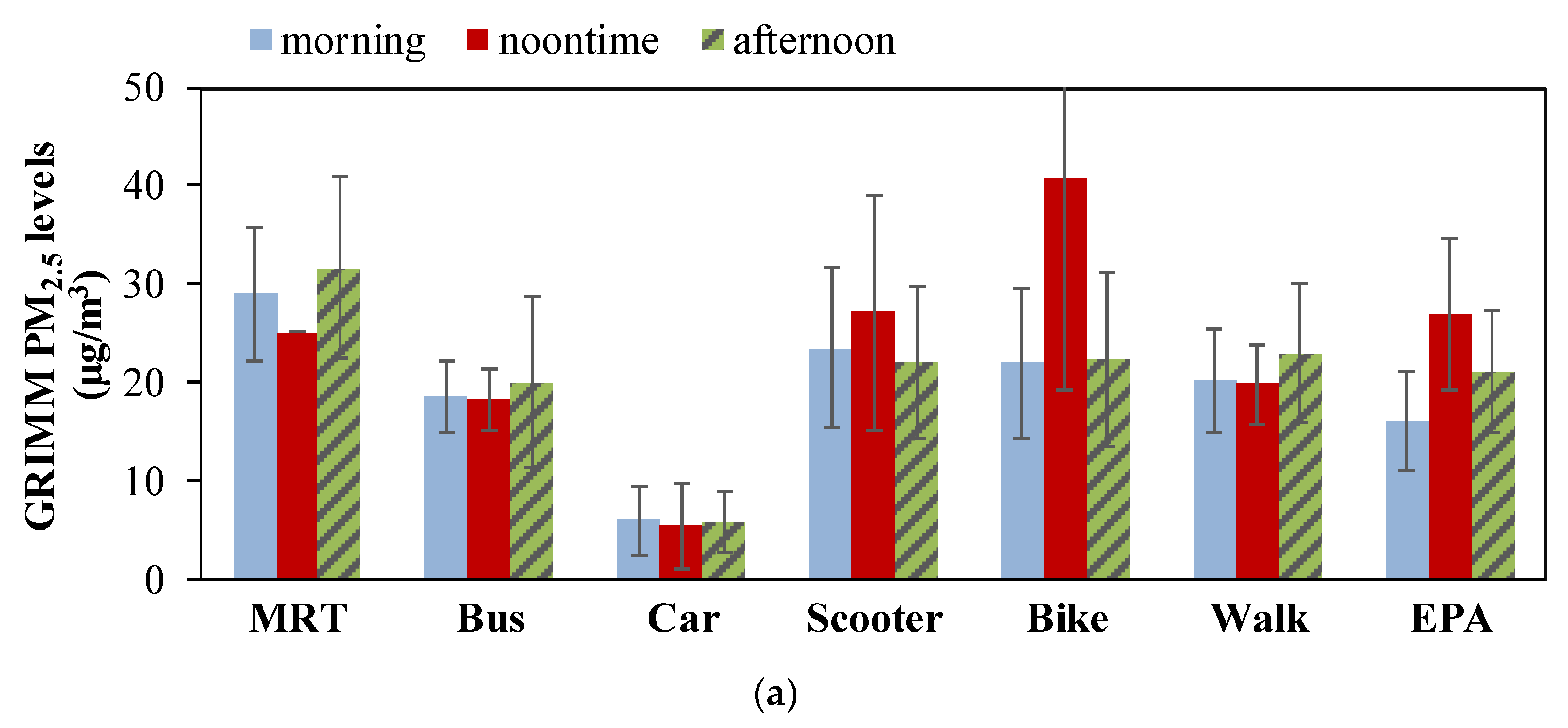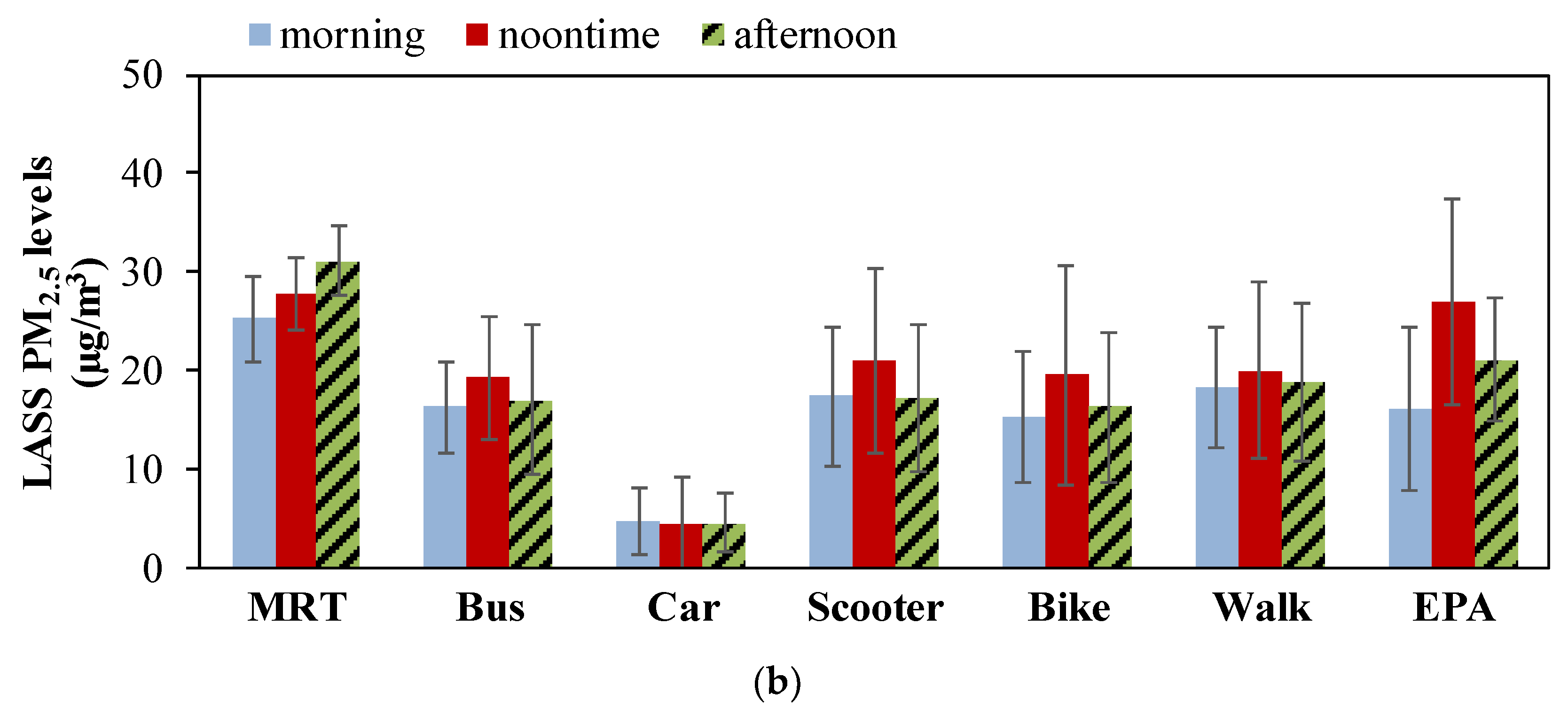Evaluation and Application of a Novel Low-Cost Wearable Sensing Device in Assessing Real-Time PM2.5 Exposure in Major Asian Transportation Modes
Abstract
:1. Introduction
2. Materials and Methods
2.1. LCS Device
2.2. Monitoring Strategy
2.3. Data Analysis
3. Results and Discussion
3.1. Performance Evaluation
3.2. PM Exposure Levels in Six Transportation Modes
3.3. Advantages and Disadvantages of LASS
4. Conclusions
Supplementary Materials
Author Contributions
Funding
Institutional Review Board Statement
Informed Consent Statement
Data Availability Statement
Acknowledgments
Conflicts of Interest
References
- Brauer, M.; Freedman, G.; Frostad, J.; Van Donkelaar, A.; Martin, R.V.; Dentener, F.; Van Dingenen, R.; Estep, K.; Amini, H.; Apte, J.S.; et al. Ambient Air Pollution Exposure Estimation for the Global Burden of Disease 2013. Environ. Sci. Technol. 2016, 50, 79–88. [Google Scholar] [CrossRef]
- Van Donkelaar, A.; Martin, R.V.; Brauer, M.; Boys, B.L. Use of Satellite Observations for Long-Term Exposure Assessment of Global Concentrations of Fine Particulate Matter. Environ. Health Perspect. 2015, 123, 135–143. [Google Scholar] [CrossRef] [Green Version]
- World Health Organization. Ambient (Outdoor) Air Quality and Health. Available online: http://www.who.int/mediacentre/factsheets/fs313/en/ (accessed on 20 June 2020).
- Pope, C.A., III; Dockery, D.W. Health effects of fine particulate air pollution: Lines that connect. J. Air Waste Manag. Assoc. 2006, 56, 709–742. [Google Scholar] [CrossRef] [PubMed]
- Pope, C.A., III; Dockery, D.W.; Spengler, J.D.; Raizenne, M.E. Respiratory health and PM10 pollution: A daily time-series analysis. Am. Rev. Respir. Dis. 1991, 144, 668–674. [Google Scholar] [CrossRef]
- United States Environmental Protection Agency (USEPA). Air Quality Criteria for Particulate Matter. Available online: https://cfpub.epa.gov/ncea/risk/recordisplay.cfm?deid=87903 (accessed on 25 June 2020).
- Forouzanfar, M.H.; Afshin, A.; Alexander, L.T.; Anderson, H.R.; Bhutta, Z.A.; Biryukov, S.; Brauer, M.; Burnett, R.; Cercy, K.; Charlson, F.J.; et al. Global, regional and national comparative risk assessment of 79 behavioural, environmental and occupational and metabolic risks or clusters of risks, 1990–2015: A systematic analysis for the Global Burden of Disease Study. Lancet 2016, 388, 1659–1724. [Google Scholar] [CrossRef] [Green Version]
- Lelieveld, J.; Evans, J.S.; Fnais, M.; Giannadaki, D.; Pozzer, A. The contribution of outdoor air pollution sources to premature mortality on a global scale. Nature 2015, 525, 367–371. [Google Scholar] [CrossRef] [PubMed]
- International Agency for Research on Cancer IARC. IARC Scientific Publication No.161: Air Pollution and Cancer. Available online: http://publications.iarc.fr/Book-And-Report-Series/Iarc-Scientific-Publications/Air-Pollution-And-Cancer-2013 (accessed on 10 July 2020).
- Mohammed, M.O.A.; Song, W.W.; Ma, W.L.; Li, W.L.; Ambuchi, J.J.; Thabit, M.; Li, Y.-F. Trends in indoor-outdoor PM2.5 research: A systematic review of studies conducted during the last decade (2003–2013). Atmos. Pollut. Res. 2015, 6, 893–903. [Google Scholar] [CrossRef]
- Lung, S.-C.C.; Mao, I.-F.; Liu, L.-J.S. Residents’ particle exposures in six different communities in Taiwan. Sci. Total Environ. 2007, 377, 81–92. [Google Scholar] [CrossRef]
- Lung, S.-C.C.; Hsiao, P.-K.; Wen, T.-Y.; Liu, C.-H.; Fu, C.B.; Cheng, Y.-T. Variability of intra-urban exposure to particulate matter and CO from Asian-type community pollution sources. Atmos. Environ. 2014, 83, 6–13. [Google Scholar] [CrossRef] [Green Version]
- Jerrett, M.; Burnet, R.T.; Ma, R.; Pope, C.A., III; Krewski, D.; Newbold, B.; Thurston, G.; Shi, Y.; Finkelstein, N.; Calle, E.E.; et al. Spatial analysis of air pollution and mortality in Los Angeles. Epidemiology 2006, 17, S69. [Google Scholar] [CrossRef]
- Pope, C.A., III; Burnett, R.T.; Thun, M.J.; Calle, E.E.; Krewski, D.; Ito, K.; Thurston, G.D. Lung cancer, cardiopulmonary mortality and long-term exposure to fine particulate air pollution. JAMA 2002, 287, 1132–1141. [Google Scholar] [CrossRef] [Green Version]
- Snyder, E.G.; Watkins, T.H.; Solomon, P.A.; Thoma, E.D.; Williams, R.W.; Hagler, G.S.W.; Shelow, D.; Hindin, D.A.; Kilaru, V.J.; Preuss, P.W. The Changing Paradigm of Air Pollution Monitoring. Environ. Sci. Technol. 2013, 47, 11369–11377. [Google Scholar] [CrossRef]
- Gao, M.; Cao, J.; Seto, E. A distributed network of low-cost continuous reading sensors to measure spatiotemporal variations of PM2.5 in Xi’an, China. Environ. Pollut. 2015, 199, 56–65. [Google Scholar] [CrossRef] [PubMed] [Green Version]
- Holstius, D.M.; Pillarisetti, A.; Smith, K.R.; Seto, E. Field calibrations of a low-cost aerosol sensor at a regulatory monitoring site in California. Atmos. Meas. Tech. 2014, 7, 1121–1131. [Google Scholar] [CrossRef] [Green Version]
- Clements, A.L.; Griswold, W.G.; Rs, A.; Johnston, J.E.; Herting, M.M.; Thorson, J.; Collier-Oxandale, A.; Hannigan, M. Low-Cost Air Quality Monitoring Tools: From Research to Practice (A Workshop Summary). Sensors 2017, 17, 2478. [Google Scholar] [CrossRef] [Green Version]
- Austin, E.; Novosselov, I.; Seto, E.; Yost, M.G. Laboratory evaluation of the Shinyei PPD42NS low-cost particulate matter sensor. PLoS ONE 2015, 10, e0141928. [Google Scholar]
- Cao, T.; Thompson, J.E. Portable, Ambient PM2.5 Sensor for Human and/or Animal Exposure Studies. Anal. Lett. 2017, 50, 712–723. [Google Scholar] [CrossRef]
- Wang, Y.; Li, J.; Jing, H.; Zhang, Q.; Jiang, J.; Biswas, P. Laboratory Evaluation and Calibration of Three Low-Cost Particle Sensors for Particulate Matter Measurement. Aerosol Sci. Technol. 2015, 49, 1063–1077. [Google Scholar] [CrossRef]
- Badura, M.; Batog, P.; Drzeniecka-Osiadacz, A.; Modzel, P. Evaluation of Low-Cost Sensors for Ambient PM2.5 Monitoring. J. Sens. 2018, 2018, 1–16. [Google Scholar] [CrossRef] [Green Version]
- Air Quality Sensor Performance Evaluation Center. PM Sensor Evaluations. Available online: http://www.aqmd.gov/aq-spec/evaluations/summary-pm (accessed on 20 July 2020).
- Kuula, J.; Mäkelä, T.; Aurela, M.; Teinilä, K.; Varjonen, S.; González, Ó.; Timonen, H. Laboratory evaluation of particle-size selectivity of optical low-cost particulate matter sensors. Atmos. Meas. Tech. 2020, 13, 2413–2423. [Google Scholar] [CrossRef]
- United States Environmental Protection Agency USEPA. Quality Assurance Handbook for Air Pollution Measurement Systems: “Volume Ⅱ: Ambient Air Quality Monitoring Program”. Available online: https://www3.epa.gov/ttn/amtic/qalist.html (accessed on 9 September 2019).
- United States Environmental Protection Agency USEPA. Air Sensor Guidebook. Available online: https://cfpub.epa.gov/si/si_public_record_report.cfm?Lab=NERL&dirEntryId=277996 (accessed on 9 September 2019).
- Jayaratne, R.; Liu, X.; Ahn, K.-H.; Asumadu-Sakyi, A.; Fisher, G.; Gao, J.; Mabon, A.; Mazaheri, M.; Mullins, B.; Nyaku, M.; et al. Low-cost PM2.5 Sensors: An Assessment of Their Suitability for Various Applications. Aerosol Air Qual. Res. 2020, 20, 520–532. [Google Scholar] [CrossRef]
- Kelly, K.; Whitaker, J.; Petty, A.; Widmer, C.; Dybwad, A.; Sleeth, D.; Martin, R.; Butterfield, A. Ambient and laboratory evaluation of a low-cost particulate matter sensor. Environ. Pollut. 2017, 221, 491–500. [Google Scholar] [CrossRef] [PubMed]
- Chen, L.-J.; Ho, Y.-H.; Lee, H.-C.; Wu, H.-C.; Liu, H.-M.; Hsieh, H.-H.; Huang, Y.-T.; Lung, S.-C.C. An Open Framework for Participatory PM2.5 Monitoring in Smart Cities. IEEE Access 2017, 5, 14441–14454. [Google Scholar] [CrossRef]
- Borghi, F.; Spinazzè, A.; Campagnolo, D.; Rovelli, S.; Cattaneo, A.; Cavallo, D.M. Precision and Accuracy of a Direct-Reading Miniaturized Monitor in PM2.5 Exposure Assessment. Sensors 2018, 18, 3089. [Google Scholar] [CrossRef] [Green Version]
- Han, I.; Symanski, E.; Stock, T.H. Feasibility of using low-cost portable particle monitors for measurement of fine and coarse particulate matter in urban ambient air. J. Air Waste Manag. Assoc. 2016, 67, 330–340. [Google Scholar] [CrossRef] [Green Version]
- Liu, H.-Y.; Schneider, P.; Haugen, R.; Vogt, M. Performance Assessment of a Low-Cost PM2.5 Sensor for a near Four-Month Period in Oslo, Norway. Atmosphere 2019, 10, 41. [Google Scholar] [CrossRef] [Green Version]
- Wang, W.-C.V.; Lung, S.-C.C.; Liu, C.H.; Shui, C.-K. Laboratory Evaluations of Correction Equations with Multiple Choices for Seed Low-Cost Particle Sensing Devices in Sensor Networks. Sensors 2020, 20, 3661. [Google Scholar] [CrossRef] [PubMed]
- Yan, C.; Zheng, M.; Yang, Q.; Zhang, Q.; Qiu, X.; Zhang, Y.; Fu, H.; Li, X.; Zhu, T.; Zhu, Y. Commuter exposure to particulate matter and particle-bound PAHs in three transportation modes in Beijing, China. Environ. Pollut. 2015, 204, 199–206. [Google Scholar] [CrossRef]
- Goel, R.; Gani, S.; Guttikunda, S.K.; Wilson, D.; Tiwari, G. On-road PM2.5 pollution exposure in multiple transport microenvironments in Delhi. Atmos. Environ. 2015, 123, 129–138. [Google Scholar] [CrossRef]
- Kumar, P.; Patton, A.P.; Durant, J.L.; Frey, H.C. A review of factors impacting exposure to PM2.5, ultrafine particles and black carbon in Asian transport microenvironments. Atmos. Environ. 2018, 187, 301–316. [Google Scholar] [CrossRef]
- Location-Aware Sensing System (LASS). Available online: https://lass-net.org/ (accessed on 15 August 2020).
- Liang, C.-S.; Yu, T.-Y.; Chang, Y.-Y.; Syu, J.-Y.; Lin, W.-Y. Source Apportionment of PM2.5 Particle Composition and Submicrometer Size Distribution during an Asian Dust Storm and Non-Dust Storm in Taipei. Aerosol Air Qual. Res. 2013, 13, 545–554. [Google Scholar] [CrossRef] [Green Version]
- Sayahi, T.; Butterfield, A.; Kelly, K. Long-term field evaluation of the Plantower PMS low-cost particulate matter sensors. Environ. Pollut. 2019, 245, 932–940. [Google Scholar] [CrossRef]
- Lung, S.C.C.; Wang, W.C.V.; Wen, T.Y.J.; Liu, C.H.; Hu, S.C. A versatile low-cost sensing device for assessing PM2.5 spatio-temporal variation and quantifying source contribution. Sci. Total Environ. 2020, 716, 137145. [Google Scholar] [CrossRef]
- Zwack, L.M.; Paciorek, C.J.; Spengler, J.D.; Levy, J.I. Characterizing local traffic contributions to particulate air pollution in street canyons using mobile monitoring techniques. Atmos. Environ. 2011, 45, 2507–2514. [Google Scholar] [CrossRef]
- Lung, S.-C.C.; Kao, M.-C. Worshippers’ exposure to particulate matter in two temples in Taiwan. J. Air Waste Manag. Assoc. 2003, 53, 130–135. [Google Scholar] [CrossRef] [Green Version]
- Taiwan Central Weather Bureau. Monthly Mean Temperature. Available online: https://www.cwb.gov.tw/V8/E/C/Statistics/monthlymean.html (accessed on 30 July 2020).
- Zheng, T.; Bergin, M.H.; Johnson, K.K.; Tripathi, S.N.; Shirodkar, S.; Landis, M.S.; Sutaria, R.; Carlson, D.E. Field evaluation of low-cost particulate matter sensors in high- and low-concentration environments. Atmos. Meas. Tech. 2018, 11, 4823–4846. [Google Scholar] [CrossRef] [Green Version]
- Che, W.; Frey, H.C.; Lau, A.K.H. Sequential Measurement of Intermodal Variability in Public Transportation PM2.5 and CO Exposure Concentrations. Environ. Sci. Technol. 2016, 50, 8760–8769. [Google Scholar] [CrossRef]
- Li, Z.Y.; Che, W.W.; Frey, H.C.; Lau, A.K.H.; Lin, C.Q. Characterization of PM2.5 exposure concentration in transport micro-environments using portable monitors. Environ. Pollut. 2017, 228, 433–442. [Google Scholar] [CrossRef]
- Qiu, Z.; Song, J.; Xu, X.; Luo, Y.; Zhao, R.; Zhou, W.; Xiang, B.; Hao, Y. Commuter exposure to particulate matter for different transportation modes in Xi’an, China. Atmos. Pollut. Res. 2017, 8, 940–948. [Google Scholar] [CrossRef]
- Ham, W.; Vijayan, A.; Schulte, N.; Herner, J.D. Commuter exposure to PM2.5, BC and UFP in six common transport micro-environments in Sacramento, California. Atmos. Environ. 2017, 167, 335–345. [Google Scholar] [CrossRef]
- Rivas, I.; Kumar, P.; Hagen-Zanker, A. Exposure to air pollutants during commuting in London: Are there inequalities among different socio-economic groups? Environ. Int. 2017, 101, 143–157. [Google Scholar] [CrossRef] [Green Version]
- Grass, D.S.; Ross, J.M.; Family, F.; Barbour, J.; Simpson, H.J.; Coulibaly, D.; Hernandez, J.; Chen, Y.; Slavkovich, V.; Li, Y.; et al. Airborne particulate metals in the New York City subway: A pilot study to assess the potential for health impacts. Environ. Res. 2010, 110, 1–11. [Google Scholar] [CrossRef] [Green Version]
- Kam, W.; Ning, Z.; Shafer, M.M.; Schauer, J.J.; Sioutas, C. Chemical Characterization and Redox Potential of Coarse and Fine Particulate Matter (PM) in Underground and Ground-Level Rail Systems of the Los Angeles Metro. Environ. Sci. Technol. 2011, 45, 6769–6776. [Google Scholar] [CrossRef] [PubMed]
- Lung, S.C.; Tsou, M.M.; Hu, S.; Hsieh, Y.; Wang, W.V.; Shui, C.; Tan, C. Concurrent assessment of personal, indoor and outdoor PM 2.5 and PM 1 levels and source contributions using novel low-cost sensing devices. Indoor Air 2020. [Google Scholar] [CrossRef] [PubMed]
- Chatzidiakou, L.; Krause, A.; Popoola, O.A.M.; Di Antonio, A.; Kellaway, M.; Han, Y.; Squires, F.A.; Wang, T.; Zhang, H.; Wang, Q.; et al. Characterising low-cost sensors in highly portable platforms to quantify personal exposure in diverse environments. Atmos. Meas. Tech. 2019, 12, 4643–4657. [Google Scholar] [CrossRef] [PubMed] [Green Version]
- Yang, F.; Lau, C.F.; Tong, V.W.T.; Zhang, K.K.; Westerdahl, D.; Ng, S.; Ning, Z. Assessment of personal integrated exposure to fine particulate matter of urban residents in Hong Kong. J. Air Waste Manag. Assoc. 2018, 69, 47–57. [Google Scholar] [CrossRef] [PubMed]
- Liang, L.; Gong, P.; Cong, N.; Li, Z.; Zhao, Y.; Chen, Y. Assessment of personal exposure to particulate air pollution: The first result of City Health Outlook (CHO) project. BMC Public Health 2019, 19, 1–12. [Google Scholar] [CrossRef] [PubMed] [Green Version]
- Sayahi, T.; Kaufman, D.; Becnel, T.; Kaur, K.; Butterfield, A.; Collingwood, S.; Zhang, Y.; Gaillardon, P.-E.; Kelly, K. Development of a calibration chamber to evaluate the performance of low-cost particulate matter sensors. Environ. Pollut. 2019, 255, 113131. [Google Scholar] [CrossRef] [PubMed]




| (a) | ||||||||||||
|---|---|---|---|---|---|---|---|---|---|---|---|---|
| Mode | PM2.5 with GRIMM in 2016 | PM2.5 with LASS in 2016 | PM10 with GRIMM in 2016 | |||||||||
| Mean (SD) | n | Mean (SD) | n | Mean (SD) | n | |||||||
| MRT | 29.6 | (8.0) | 11 | 27.6 | (4.7) | 53 | 35.4 | (8.9) | 11 | |||
| Bus | 20.8 | (7.5) | 13 | 17.2 | (6.2) | 53 | 27.9 | (7.3) | 13 | |||
| Car | 5.6 | (3.6) | 62 | 4.6 | (3.3) | 60 | 6.7 | (4.0) | 62 | |||
| Scooter | 22.7 | (8.9) | 58 | 18.0 | (7.9) | 57 | 28.4 | (9.5) | 58 | |||
| Bike | 25.9 | (14.6) | 14 | 16.9 | (8.3) | 56 | 34.1 | (16.2) | 14 | |||
| Walk | 21.3 | (6.3) | 12 | 18.8 | (7.6) | 58 | 29.4 | (7.6) | 12 | |||
| (b) | ||||||||||||
| Mode | PM2.5 with GRIMM in 2016 | PM2.5 with LASS in 2016 | PM10 with GRIMM in 2016 | |||||||||
| Mean (SD) | Max/Mean 1 (Range) 2 | n | Mean (SD) | Max/Mean (Range) | n | Mean (sd) | Max/Mean (Range) | n | ||||
| MRT | 29.8 | (9.2) | (1.1, 1.3) | 114 | 27.6 | (5.4) | (1.0, 1.4) | 565 | 35.5 | (10.4) | (1.1, 1.3) | 114 |
| Bus | 19.9 | (8.0) | (1.1, 1.7) | 120 | 17.5 | (7.1) | (1.0, 1.9) | 493 | 27.0 | (11.7) | (1.2, 3.1) | 120 |
| Car | 5.9 | (4.2) | (1.0, 3.4) | 666 | 4.9 | (4.0) | (1.0, 3.6) | 614 | 7.1 | (5.6) | (1.1, 5.2) | 666 |
| Scooter | 22.3 | (9.5) | (1.0, 2.3) | 614 | 17.8 | (8.3) | (1.0, 2.7) | 574 | 28.2 | (11.9) | (1.0, 3.2) | 614 |
| Bike | 25.7 | (13.7) | (1.0, 1.2) | 122 | 17.2 | (8.4) | (1.0, 2.7) | 541 | 34.2 | (16.0) | (1.0, 1.9) | 122 |
| Walk | 21.3 | (6.9) | (1.1, 1.4) | 138 | 18.6 | (8.0) | (1.0, 2.1) | 612 | 29.6 | (10.2) | (1.2, 2.9) | 138 |
| (c) | ||||||||||||
| Mode | PM2.5 with PEM in 2004 | PM2.5 with PEM in 2005 | ||||||||||
| Mean (SD) | n | Mean (SD) | n | |||||||||
| MRT | 128.7 | (73.4) | 15 | 68.1 | (33.7) | 15 | ||||||
| Bus | - | - | - | - | - | - | ||||||
| Car | 104.5 | (64.0) | 15 | 75.6 | (35.1) | 15 | ||||||
| Scooter | 179.8 | (70.2) | 14 | 153.3 | (67.2) | 15 | ||||||
| Bike | - | - | - | - | - | - | ||||||
| Walk | - | - | - | - | - | - | ||||||
| (a) | |||
|---|---|---|---|
| Mode | Parameter Estimate | Standard Error | p-Value |
| Intercept (car) | −26.7 | 15.2 | 0.081 |
| MRT | 15.9 | 3.9 | 0.000 |
| Bus | 4.6 | 3.8 | 0.226 |
| Scooter | 9.9 | 4.8 | 0.040 |
| Bike | 9.3 | 5.1 | 0.068 |
| Walk | 4.9 | 5 | 0.329 |
| Air temperature | −0.1 | 0.4 | 0.843 |
| Relative Humidity | 0.4 | 0.1 | 0.002 |
| (b) | |||
| Mode | Parameter Estimate | Standard Error | p-Value |
| Intercept (car) | −19.2 | 11.4 | 0.095 |
| MRT | 15.6 | 2.4 | 0.000 |
| Bus | 6.7 | 2.6 | 0.010 |
| Scooter | 8.1 | 3.6 | 0.025 |
| Bike | 6.1 | 3.6 | 0.092 |
| Walk | 7.1 | 3.6 | 0.048 |
| Air temperature | −0.3 | 0.3 | 0.261 |
| Relative Humidity | 0.3 | 0.1 | 0.000 |
| Location | Transportation Mode | Instrument | Year of Field Work | Reference | |||||
|---|---|---|---|---|---|---|---|---|---|
| Subway | AC Bus | AC Car | Scooter | Bike | Walk | ||||
| Asia, review | - | 76 (62) | 74 (61) | 86.3 (55.7) | 49 (27) | 42 (31) | varied instrument 1 | before 2014 | Kumar et al. [36] |
| Beijing, China | 61.8 (21.6) | 38.9 (26.3) | - | - | - | 49.9 (51.7) | TSI DustTrak | 2011 | Yan et al. [34] |
| Delhi, India | - | 315 (105) | - | - | 347 (94) | 231 (72) | TSI DustTrak | 2014 | Goel et al. [35] January |
| Delhi, India | 87 (141) | 140 (56) | 56 (44) | - | - | 234 (184) | TSI DustTrak | 2014 | Goel et al. [35] April |
| Hong Kong | 19 (1.1) | 19 (2.1) | - | - | - | 38 (3.2) | TSI DustTrak II | 2014 | Che et al. [45] lunchtime |
| Hong Kong | 23 (1.5) | - | - | - | - | 43 (3.6) | TSI DustTrak II | 2014 | Che et al. [45] evening |
| Hong Kong | 31 (13) | 39 (21) | - | - | - | - | TSI DustTrak | 2015 | Li et al. [46] |
| Xian, China | 43.2 (24.2) | 54.4 (7.15) | 10.1 (6.63) | - | - | 71.6 (5.11) | GRIMM 1.109 | 2016 | Qiu et al. [47] morning |
| Xian, China | 43.4 (9.72) | - | 8.95 (1.08) | - | - | 65.8 (11.0) | GRIMM 1.109 | 2016 | Qiu et al. [47] afternoon |
| US, review | - | 59 (59) | 46 (36) | - | 11 (5) | 35 (13) | varied instrument 1 | before 2014 | Kumar et al. [36] |
| Sacramento, CA, US | - | 7.47 (2) | 7.1 (3.3) | - | 9.56 (4) | - | TSI DustTrak | 2014-2015 | Ham et al. [48] |
| Europe, review | - | 47 (37) | 32 (30) | - | 43 (27) | 26 (18) | varied instrument 1 | before 2014 | Kumar et al. [36] |
| London, UK 2 | 34.5 (2.9) | 13.9 (1.7) | 7.3 (2) | - | - | - | GRIMM EDM 107 | 2016 | Rivas et al. [49] |
Publisher’s Note: MDPI stays neutral with regard to jurisdictional claims in published maps and institutional affiliations. |
© 2021 by the authors. Licensee MDPI, Basel, Switzerland. This article is an open access article distributed under the terms and conditions of the Creative Commons Attribution (CC BY) license (http://creativecommons.org/licenses/by/4.0/).
Share and Cite
Wang, W.-C.V.; Lung, S.-C.C.; Liu, C.-H.; Wen, T.-Y.J.; Hu, S.-C.; Chen, L.-J. Evaluation and Application of a Novel Low-Cost Wearable Sensing Device in Assessing Real-Time PM2.5 Exposure in Major Asian Transportation Modes. Atmosphere 2021, 12, 270. https://doi.org/10.3390/atmos12020270
Wang W-CV, Lung S-CC, Liu C-H, Wen T-YJ, Hu S-C, Chen L-J. Evaluation and Application of a Novel Low-Cost Wearable Sensing Device in Assessing Real-Time PM2.5 Exposure in Major Asian Transportation Modes. Atmosphere. 2021; 12(2):270. https://doi.org/10.3390/atmos12020270
Chicago/Turabian StyleWang, Wen-Cheng Vincent, Shih-Chun Candice Lung, Chun-Hu Liu, Tzu-Yao Julia Wen, Shu-Chuan Hu, and Ling-Jyh Chen. 2021. "Evaluation and Application of a Novel Low-Cost Wearable Sensing Device in Assessing Real-Time PM2.5 Exposure in Major Asian Transportation Modes" Atmosphere 12, no. 2: 270. https://doi.org/10.3390/atmos12020270
APA StyleWang, W.-C. V., Lung, S.-C. C., Liu, C.-H., Wen, T.-Y. J., Hu, S.-C., & Chen, L.-J. (2021). Evaluation and Application of a Novel Low-Cost Wearable Sensing Device in Assessing Real-Time PM2.5 Exposure in Major Asian Transportation Modes. Atmosphere, 12(2), 270. https://doi.org/10.3390/atmos12020270







